Workouts for Week 1
It’s all About the CORE!
When athletes produce the necessary movements in their sports with increased efficiency, their overall performance improves. Greater strength of the core musculature increases the stability of the pelvis and spine and improves body control or balance during athletic movements, thus enhancing the efficiency of movement.
Core strength training can enhance neuromuscular reaction and this can lead to improved athletic performance. A stronger core requires less forceful contractions of the peripheral muscles to produce a given amount of power, so the muscles – both in the core and in the stabilization – are less likely to be injured during training and competition.
Core strengthening requires the regular and proper exercise of your body’s 29 core muscles.
A strong core gives you:
- Increased protection and “bracing” for your back
- Controlled movement
- A more stable center of gravity
- A more stable platform for sports movements
When you have good core stability, the muscles in your pelvis, lower back, hips, and abdomen work in harmony. They provide support to your spine for just about any activity.
A weak core can make you susceptible to poor posture, lower back pain, and muscle injuries. Strong core muscles provide the brace of support needed to help prevent such pain and injury.
Exercises that are crucial in core strength development:
Prone Bridge (Bows and Toes)
In a prone position on a floor mat, the athlete balances on the tips of toes and elbows while attempting to maintain a straight line from heels to head. This exercise focuses on both the anterior and posterior muscle groups of the trunk and pelvis.
Lateral Bridge (Bridge Right and Bridge Left)
In a sideways posture on a floor mat, the athlete balances on one elbow and the side of one foot while attempting to keep the body aligned in a straight line. This exercise focuses on the abdominal obliques and transverse abdominus. Also, the lateral bridge teaches the athlete how to sense the proper pelvic position.
Supine Bridge
In a supine posture on a floor mat, the athlete raises the hips so that only the head, shoulders, and feet are touching the mat. The supine bridge focuses on the gluteal muscles. Stronger glutes help maintain pelvic control, which is important for movements that require hip extension.
Follow these guidelines when training your core:
- Do your core exercises at least three times a week
- Choose exercises that work your core muscles simultaneously. Rather than isolate each muscle group in your trunk, the best exercises for your core are those that get muscles working together at the same time.
- Focus on quality of movement rather than quantity. You’ll gradually build up to a greater number of repetitions. When starting out, take it slow and learn how to properly perform each exercise with optimal technique.
- Breathe steadily and slowly. Breathe freely while doing each of the exercises in your core strengthening workout. Your instinct may be to hold your breath during an exercise, but it’s better to continue breathing.
- Take a break when you need one. When your muscles get tired, stop and change exercises. And, if you work your core muscles to fatigue during an exercise session, wait at least a day between workouts to allow the muscles to recover.
Keep in mind that strengthening workouts — even core strengthening — are just one part of a complete fitness program. Include aerobic exercise and flexibility training to round out your regimen.
Click on the number below that corresponds to the week of training you’re in.
Workouts for Week 2
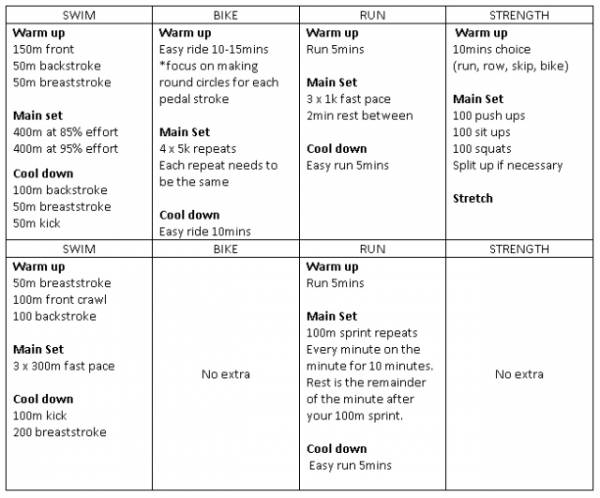
Click on the number below that corresponds to the week of training you’re in.
Workouts for Week 3
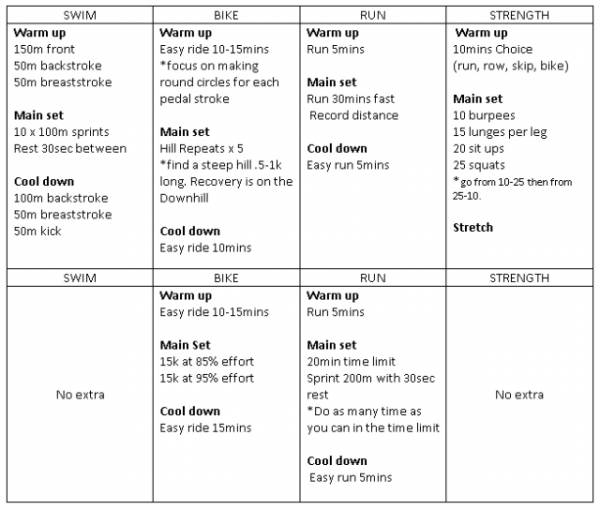
Click on the number below that corresponds to the week of training you’re in.
Workouts for Week 4
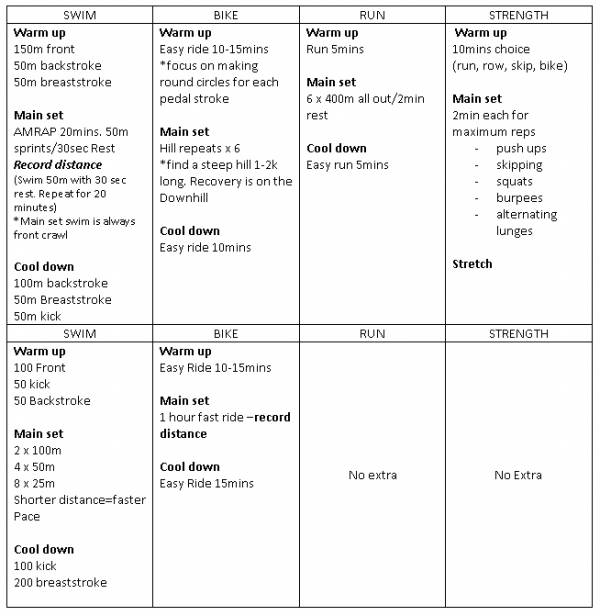
The Small Things Make a Difference in your Training
At the risk of sounding like those commercials that promise you can lose a bunch of weight while still eating anything and everything, I’m going to let you in on how to get faster by doing nothing. Well, not exactly nothing, but you won’t have to raise your heart rate, put out 300 watts, or really even break a sweat. What I’m getting at is that there are several ways to become a faster triathlete while sitting at home.
First, you can easily stretch while watching your favorite nightly programming. Just sprawl out on the floor and work those tight spots out. You can easily incorporate a good routine that fits within the usual 30 minute TV show. While you’re at it, why not take it to the next level and incorporate some self body-work. Use devices such as The Stick, or the T.P. Massage Kit to really break up trigger points or lengthen your IT band.
Take the minimal effort to drive yourself to your local massage therapist, chiropractor, physical therapist, acupuncturist, the list is endless, and get some professional bodywork. We spend so much time beating up our bodies. We need to replenish and rejuvenate as well. When your body is functioning correctly you will be able to get the most from your training.
Third, track your progress and look over your program. Hopefully you are using some form of tracking, either a web based program like TrainingPeaks, or the simple pen and paper method. Either way, by logging your workouts, you are able to look back on what was effective and what didn’t work. Look for trends in your training. When did you have good workouts? Can you pinpoint anything specific about the lead in to that workout or period?
On the subject of tracking your training, try tracking your recovery. For one week take note of the time you spend stretching, doing yoga or your hour massage. We all know that recovery is the key to strong training and faster racing, so why not track it like we do our weekly yardage or hours?
Some athletes track their nutrition. Once a month note what you eat every day for one week. There are some computer programs that allow you to compare your calories expended with your calories taken in, so you can see if you are in a calorie deficit, or surplus. This is useful if you are trying to determine your optimum training or racing weight.
Finally, and the ultimate in terms of ease of use and price, SLEEP! Take your sleep patterns seriously. If you regularly get less than 7 hours of sleep per night, try getting 8 for one week and see the difference. Once you experience the extra energy, you won’t be so tempted to watch David Letterman.
So, with very little effort you can take your training to a new level. The key is to just get started and incorporate these modalities into your daily routine. Try any one of the suggestions above and see the results for yourse
Click on the number below that corresponds to the week of training you’re in.
Workouts for Week 5
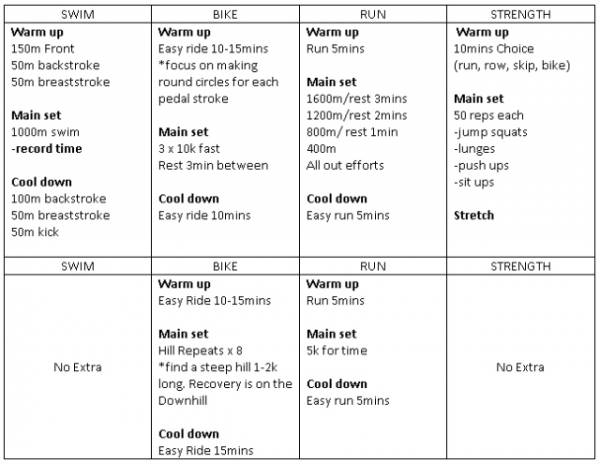
Click on the number below that corresponds to the week of training you’re in.
Workouts for Week 6
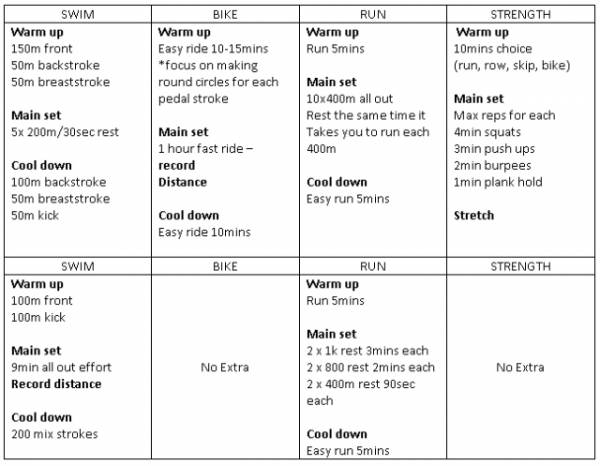
Click on the number below that corresponds to the week of training you’re in.
Workouts for Week 7
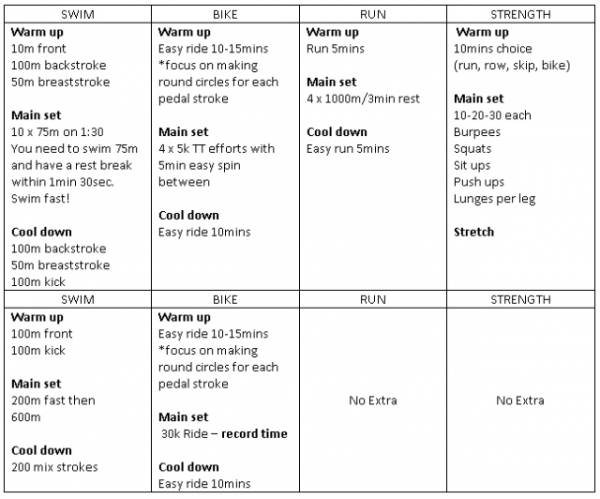
Click on the number below that corresponds to the week of training you’re in.
Workouts for Week 8
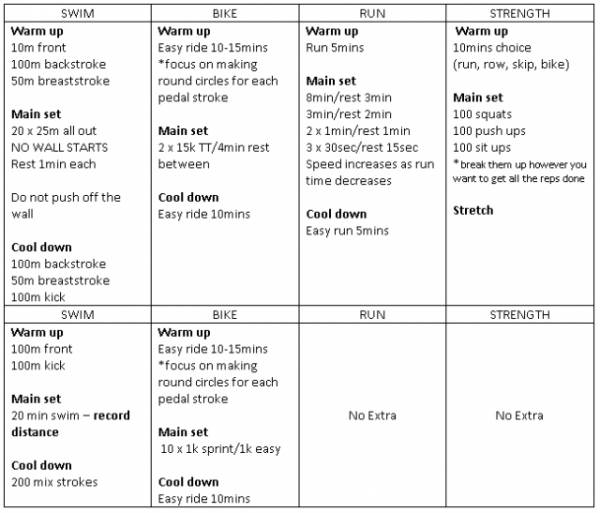
After this week we will switch our biking to indoor sessions. These can be done on your bike trainer or on a spin bike. If you are lucky enough to live somewhere without snow you can still do the workouts outside on your bike.
Click on the number below that corresponds to the week of training you’re in.
Workouts for Week 9
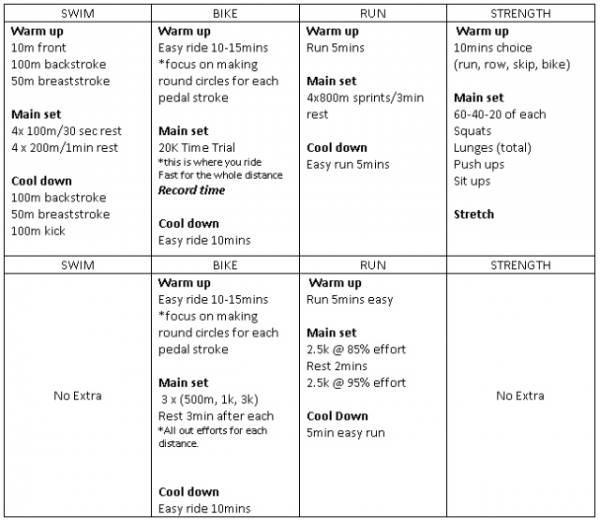
Cold Weather Running
On a calm winter day, our bodies insulate us somewhat from the outside temperature by warming up a thin layer of air close to our skin, known as the boundary layer. When the wind blows, it takes this protective layer away – exposing our skin to the outside air. It takes energy for our body to warm up a new layer, and if the boundary layer keeps getting blown away, our skin temperature will drop, and we will feel colder.
Wind also makes you feel colder by evaporating any moisture on your skin – a process that draws more heat away from your body. Studies show that when your skin is wet (with sweat, for example) it loses heat much faster than when it’s dry. Wet clothing and footwear that loses its insulating value results in heat loss nearly equal to that of exposed skin. Check the wind chill before you go out for your run, even moderate wind chill values can be dangerous if you are out for long periods. And remember your layers!
Sixteen cold weather training tips:
- Adjust the intensity of your workout. You may have to decide on a time rather than distance.
- 50% of the body’s heat is lost through the head. Wear a toque.
- Warm up properly and start at a slower pace.
- Shorten your stride to improve your footing on icy roads. Think about adding some traction devices to your shoes.
- Carry your phone or change for a payphone. Think about carrying cab fare also.
- Run into the wind and coast home with it at your back.
- Run with a group if possible. If you run by yourself, find a route that allows you to cut your run short and where help is readily available.
- Tell someone where you are going. Give them your route and estimate how long you will be out.
- Don’t run lonely trails by yourself. If you slip or fall, a twisted ankle or broken bone could leave you helpless.
- In very cold temperatures, cover all exposed skin with clothing or petroleum jelly for protection.
- Run facing oncoming traffic and wear your reflective gear.
- Chapstick your nose, lips and ears. Mittens are warmer than gloves.
- Men should wear a wind brief to protect for future generations.
- Keep your speed workouts for indoors or dry roads.
- Seek a warm dry place if you suspect hypothermia. Hypothermia is caused by a sudden drop in the body’s core temperature. It can be very dangerous! Signs are incoherent, slurred speech, clumsy fingers and other signs of poor coordination. Wet, windy days are often when difficulty is experienced.
- So far, no one has had frozen lungs in subzero weather. The air is warmed by the body before it enters the body. If you find breathing cold air uncomfortable, wear a face mask to help warm the air. Or stay inside and find a treadmill.
The mental discipline that is often needed to get one foot out the door when it’s cold is exactly what comes in handy during the later stages of a marathon or long distance triathlon.
Click on the number below that corresponds to the week of training you’re in.
Workouts for Week 10
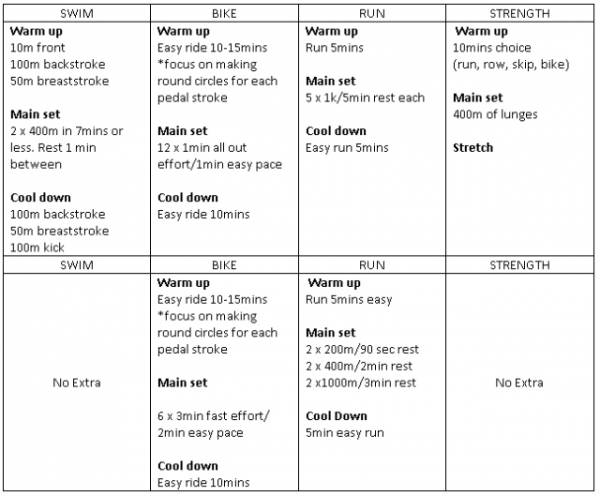
Click on the number below that corresponds to the week of training you’re in.
Workouts for Week 11
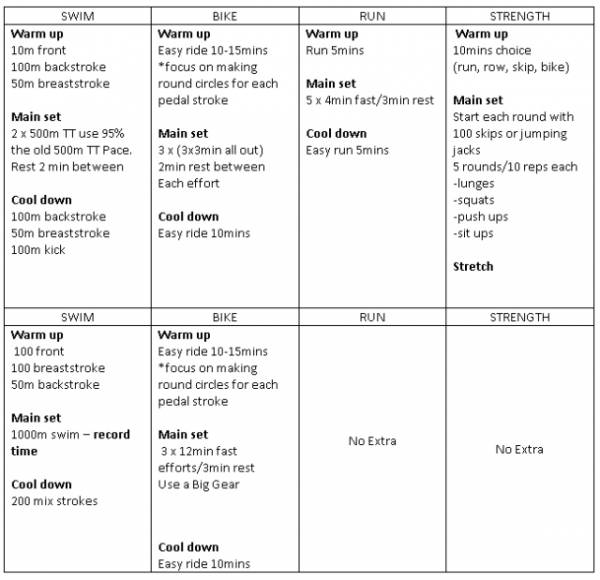
Another 12 weeks draws to a close and we will add in some more strength training for the next block. I will keep the bodyweight workouts for those of you that do not have access to a gym or weights but will be adding in some weighted movements.
You can do both strength workouts and still swim, bike and run, However, you must still take a day off to rest and recover. I will rotate the swim, bike and run workouts every week to make sure you don’t do too much. Remember not to make up missed workouts all in one day or skip your rest day.
Send me a tweet to let me know how your training is going! @ironmum
Click on the number below that corresponds to the week of training you’re in.
Workouts for Week 12
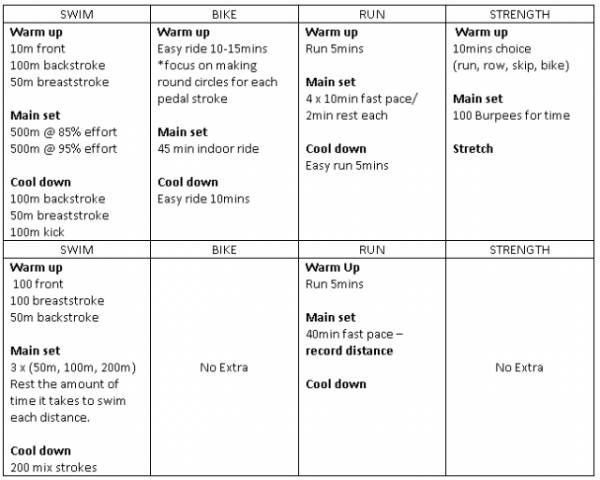
Click on the number below that corresponds to the week of training you’re in.






